While idly watching a diving Red-necked Grebe at Humber Bay East in early April, I chanced to watch it catch quite a large fish. At the time, the fins and colouring of the fish suggested a possible breed to me and when I got home I checked the photos against my field guides. Yes, the Red-necked Grebe had been having an early supper of a Round Goby.
Why Are Round Goby So Successful in Some of These Small Lake Ontario Waterways?
When I was watching the pair of Grebes at Humber Bay East park from the “floating” boardwalk, I met a pleasant woman who was fishing with a dip net. She wasn’t checking on fish or insect larvae, though. She was fishing garbage out of the water and said she has been doing this for years. Unfortunately, there is always more for her to find and retrieve.
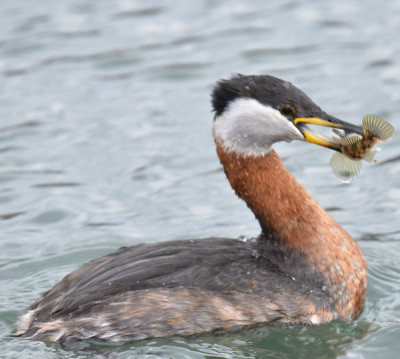
Here’s the Grebe with the Goby
Round Goby are a hardy fish that can tolerate poor water conditions. Unlike some of our native fish, they can successfully live and breed in these degraded waterways.
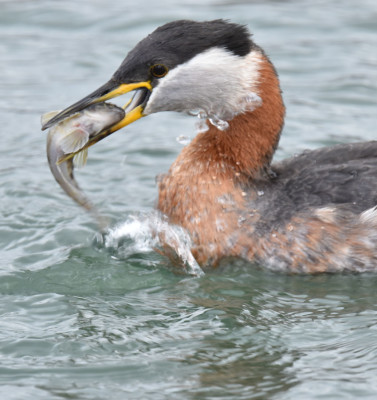
This photo shows the odd underside fin that may give the “Round” Goby its name: The pelvic fins are fused together into a shape a bit like a cupcake-wrapper.
There is another alien species can also tolerate these less-than-pristine conditions: Zebra Mussels. According to the Invading Species website, Round Goby eat large numbers of zebra mussels. That means the Goby have an abundant food source in a waterway without much competition from other fish less tolerant of degradation.
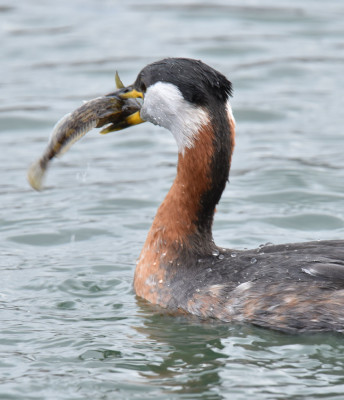
It took almost a minute for the Grebe to arrange the Goby so that it could swallow it head first. That reduces the chance of the spines in the first dorsal (upper) fin of the fish sticking in the Grebes throat.
Isn’t It a Good Thing That Grebes Will Eat This invasive Species of Fish?
Yes and no. It’s good that the Red-necked Grebe is finding something to eat.

It took a bit of swallowing to get such a big fish down!
But when I was reading about the Round Goby I discovered that they have been tentatively linked to outbreaks of botulism type E in Great Lakes fish and fish-eating birds.
Apparently, the botulism may be collected by zebra mussels, which are eaten by the Goby, which are then eaten by birds like this Grebe. While not directly causing harm to humans, this poisoning can lead to large numbers of fish and birds dying. That, of course, is both saddening and can be harmful to humans coming in contact with the dead creatures.
What Is That Square Raft of Floating Boards Beside the Boardwalk or Dock?
At Bronte Harbour, Lakefront Promenade, Colonel Sam Smith Park’s Marina, and at Humber Bay, you may notice small square rafts anchored in the water. These are nesting platforms being provided for the Red-necked Grebes.
Like loons, Red-necked Grebes have legs attached so far back on their body that they cannot balance well to walk or waddle when ashore like a Mallard does. Instead, they have to almost body-surf across the mud and plants when ashore. That means they build their nests quite close to the water where it’s flat enough to slide in and out.
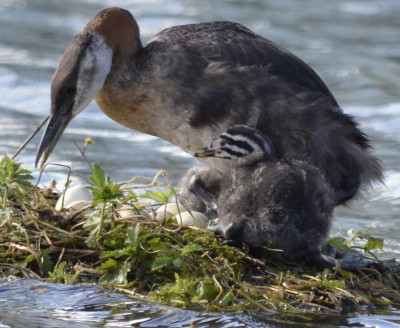
The raft under this vegetation is hard to see. This is a nest at Bronte Harbour a few summers ago.
These parks lack that type of edge. By building these rafts, people have created suitable nesting habitat for the Grebes. The birds drag large piles of plant material on top of the raft to build their nest. Pairs have successfully raised chicks at various locations throughout the Toronto to Hamilton area.
I’ll check on how nesting is going for the Grebes at Humber Bay the next time I visit. For now, I was quite happy just to watch them fishing.
Related Reading
- What Water Bird’s Chicks Have Zebra-Striped Faces?
- A Four Grebe Day!
- A Pied-billed Grebe
- Ontario’s Invading Species Awareness Program: Round Goby
Join In
Is there a pair of Red-necked Grebes nesting near you? Have you been able to identify any of the fish they have caught? Please share your sighting with a comment.

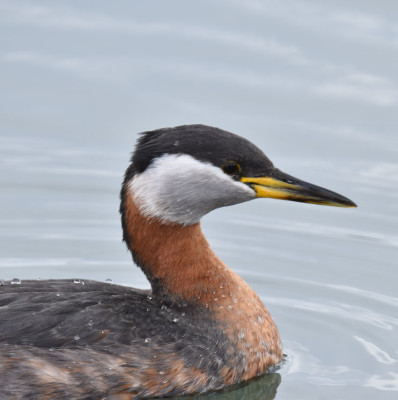

Cool blog and shots! I initially noticed your “Grebe vs Fish” series. Wow, that looked like a pretty spiky/big fish she took on here!
So did the Grebe really manage to get the whole thing (it looks almost stuck in her neck in the last shot!) down okay?? Does the unlucky prey get swallowed wriggling all the way as well?!
Yes, the Grebe finished the fish and went on to catch and eat a couple of others. The fish had stopped struggling before she swallowed it, so I suspect it may have suffocated by that time?